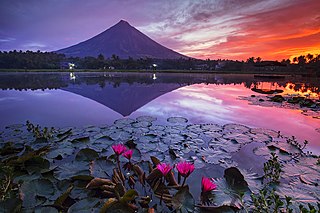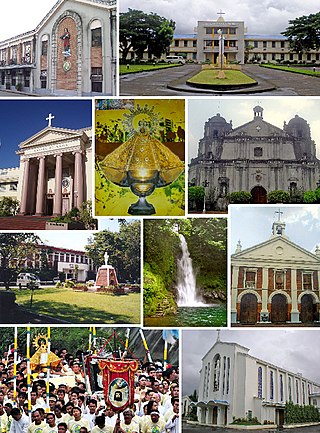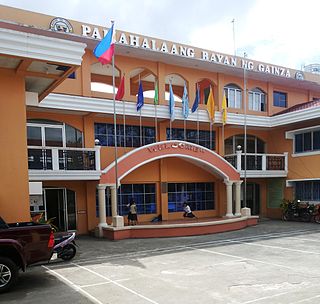
Albay, officially the Province of Albay, is a province in the Bicol Region of the Philippines, mostly on the southeastern part of the island of Luzon. Its capital is the city of Legazpi, the regional center of the whole Bicol Region, which is located in the southern foothill of Mayon Volcano.

The Bicol Region, commonly shortened to Bicol and designated as Region V, is an administrative region of the Philippines. Also referred to as Bicolandia, it comprises six provinces, four on the Bicol Peninsula : Albay, Camarines Norte, Camarines Sur, and Sorsogon, and two off the shore: Catanduanes and Masbate.

Camarines Sur, officially the Province of Camarines Sur, is a province in the Philippines located in the Bicol Region on Luzon. Its capital is Pili and the province borders Camarines Norte and Quezon to the northwest, and Albay to the south. To the east lies the island province of Catanduanes across the Maqueda Channel.

Camarines Norte, officially the Province of Camarines Norte, is a province in the Philippines located in the Bicol Region in Luzon. Its capital is Daet. The province borders Quezon to the west, Camarines Sur to the south, and the Philippine Sea to the north. It has historically been a Bikol-speaking region. However, there has been a language shift in recent years to Tagalog, which is more commonly used nowadays.

Libon, officially the Municipality of Libon, is a 1st class municipality in the province of Albay, Philippines. According to the 2020 census, it has a population of 75,073 people.

Naga, officially the City of Naga, or the Pilgrim City of Naga, is a 1st class independent component city in the Bicol Region of the Philippines. According to the 2020 census, it has a population of 209,170 people.

Gainza, officially the Municipality of Gainza, is a 5th class municipality in the province of Camarines Sur, Philippines. According to the 2020 census, it has a population of 11,584 people, making it the least populated municipality in the province.

Goa, officially the Municipality of Goa, is a 1st class municipality in the province of Camarines Sur, Philippines. According to the 2020 census, it has a population of 71,368 people.

Iriga, officially the City of Iriga, is a component city in the province of Camarines Sur, Philippines. According to the 2020 census, it has a population of 114,457 people.

Lagonoy, officially the Municipality of Lagonoy, is a 2nd class municipality in the province of Camarines Sur, Philippines. According to the 2020 census, it has a population of 56,714 people.

The Metropolitan Archdiocese of Cáceres is a Latin Church archdiocese of the Catholic Church in the Philippines. It is a metropolitan see that comprises the Bicol Region, while directly overseeing the third, fourth, and fifth congressional districts of Camarines Sur, Naga City, Iriga City and the Municipality of Gainza. The archdiocese, having been founded in 1595 in Nueva Cáceres, is also considered one of the oldest dioceses in the Philippines with Cebu, Segovia and Manila, and once had jurisdiction that stretched from Samar in the south and Isabela Province in the north. The seat of the archdiocese is currently located in Naga City, also known as the Queen City of Bicol.
The legislative districts of Ambos Camarines were the representations of the historical province of Ambos Camarines in the various national legislatures of the Philippines until 1919.

Nueva Cáceres, officially the City of Nueva Cáceres, was a colonial Spanish city in the Philippines. Established by Captain Pedro de Sanchez in 1575, the city was named in honor of Governor-General Francisco de Sande who was a native of Cáceres, Spain. In 1595, a papal bull coming from the Holy See created the See of Cáceres under the Archdiocese of Manila.

The Camarines Sur National High School, also called CamHi, is the oldest national high school in Camarines Sur and one of the biggest public secondary schools in the Bicol Region, Philippines, having a student population of 11,899 in the school year 2021–2022. It was established in 1902.

Tomás Arejola y Padilla was a Filipino lawyer, legislator, diplomat, political writer and a propagandist during the Spanish colonial period. A mason and a liberal, he openly campaigned for political reforms in the Philippines. But this was to pass and the Americans took over. During the Commonwealth period, Arejola joined the Nacionalista Party becoming its first vice-president and twice in the elections of 1907 and 1911 was elected the Representative of Ambos Camarines.

The Partido is a district in Camarines Sur, a province of the Philippines, that was formerly known as the Partido de Ibalon. The Spanish divided the Bicol Region into two distinct areas at the present province of Camarines Sur, the southern part becoming known as the Partido.
Felix Abad Fuentebella was the Representative of the Second District of Camarines Sur in the Philippines from 1954 to 1972 and the Provincial Governor of Camarines Sur from 1976 until 1986. He is the son of former Ambos Camarines Governor Mariano Fuentebella and the half brother of Jose Fuentebella and Manuel Fuentebella.

The Bikol languages or Bicolano languages are a group of Central Philippine languages spoken mostly in the Bicol Peninsula in the southeastern part of Luzon, the neighboring island-province of Catanduanes, and the island of Burias in Masbate.
The COVID-19 pandemic in the Bicol Region is part of the worldwide pandemic of coronavirus disease 2019 caused by severe acute respiratory syndrome coronavirus 2. The virus reached the Bicol Region on March 27, 2020, when the first case of the disease was confirmed in Albay.
Camarines refers to Ambos Camarines, a former province of the Philippines (1579-1919).















